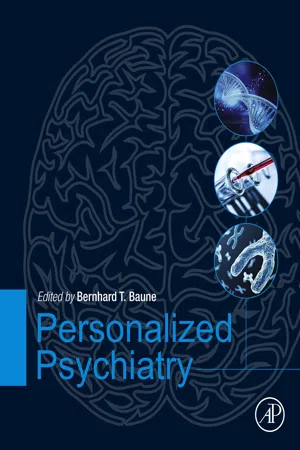
- 604 pages
- English
- ePUB (mobile friendly)
- Available on iOS & Android
Personalized Psychiatry
About this book
Personalized Psychiatry presents the first book to explore this novel field of biological psychiatry that covers both basic science research and its translational applications. The book conceptualizes personalized psychiatry and provides state-of-the-art knowledge on biological and neuroscience methodologies, all while integrating clinical phenomenology relevant to personalized psychiatry and discussing important principles and potential models. It is essential reading for advanced students and neuroscience and psychiatry researchers who are investigating the prevention and treatment of mental disorders.- Combines neurobiology with basic science methodologies in genomics, epigenomics and transcriptomics- Demonstrates how the statistical modeling of interacting biological and clinical information could transform the future of psychiatry- Addresses fundamental questions and requirements for personalized psychiatry from a basic research and translational perspective
Frequently asked questions
- Essential is ideal for learners and professionals who enjoy exploring a wide range of subjects. Access the Essential Library with 800,000+ trusted titles and best-sellers across business, personal growth, and the humanities. Includes unlimited reading time and Standard Read Aloud voice.
- Complete: Perfect for advanced learners and researchers needing full, unrestricted access. Unlock 1.4M+ books across hundreds of subjects, including academic and specialized titles. The Complete Plan also includes advanced features like Premium Read Aloud and Research Assistant.
Please note we cannot support devices running on iOS 13 and Android 7 or earlier. Learn more about using the app.
Information
What is personalized psychiatry and why is it necessary?
Department of Psychiatry, Melbourne Medical School, The University of Melbourne, Melbourne, VIC, Australia
The Florey Institute of Neuroscience and Mental Health, The University of Melbourne, Parkville, VIC, Australia
Abstract
Keywords
The modeling of trajectories in psychotic illness
b Northern Adelaide Local Health Network, Mental Health Service, Adelaide, SA, Australia
c Department of Psychiatry and Psychotherapy, University of Münster, Münster, Germany
d Department of Psychiatry, Melbourne Medical School, The University of Melbourne, Melbourne, Australia
e The Florey Institute of Neuroscience and Mental Health, The University of Melbourne, Parkville, VIC, Australia
Abstract
Keywords
1 Introduction
Table of contents
- Cover image
- Title page
- Table of Contents
- Copyright
- Contributors
- Preface
- Chapter 1: What is personalized psychiatry and why is it necessary?
- Chapter 2: The modeling of trajectories in psychotic illness
- Chapter 3: Mood trajectories as a basis for personalized psychiatry in young people
- Chapter 4: Transdiagnostic early intervention, prevention, and prediction in psychiatry
- Chapter 5: Early intervention, prevention, and prediction in mood disorders: Tracking multidimensional outcomes in young people presenting for mental health care
- Chapter 6: Consumer participation in personalized psychiatry
- Chapter 7: Experimental validation of psychopathology in personalized psychiatry
- Chapter 8: Deep brain stimulation for major depression: A prototype of a personalized treatment in psychiatry
- Chapter 9: The Psychiatric Genomics Consortium: History, development, and the future
- Chapter 10: Statistical genetic concepts in psychiatric genomics
- Chapter 11: Opportunities and challenges of machine learning approaches for biomarker signature identification in psychiatry
- Chapter 12: Personalized psychiatry with human iPSCs and neuronal reprogramming
- Chapter 13: Genetics of alcohol use disorder
- Chapter 14: Genomics of autism spectrum disorders
- Chapter 15: Genomics of schizophrenia
- Chapter 16: Genomics of major depressive disorder
- Chapter 17: Personalized mental health: Artificial intelligence technologies for treatment response prediction in anxiety disorders
- Chapter 18: The genetic architecture of bipolar disorder: Entering the road of discoveries
- Chapter 19: Genomics of borderline personality disorder
- Chapter 20: Genetics of obsessive-compulsive disorder and Tourette disorder
- Chapter 21: Genetics and pharmacogenetics of attention deficit hyperactivity disorder in childhood and adulthood
- Chapter 22: Genomics of Alzheimer’s disease
- Chapter 23: Current progress and future direction in the genetics of PTSD: Focus on the development and contributions of the PGC-PTSD working group
- Chapter 24: Genomic contributions to anxiety disorders
- Chapter 25: Proteomics for diagnostic and therapeutic blood biomarker discovery in schizophrenia and other psychotic disorders
- Chapter 26: Molecular biomarkers in depression: Toward personalized psychiatric treatment
- Chapter 27: Neuroimaging biomarkers of late-life major depressive disorder pathophysiology, pathogenesis, and treatment response
- Chapter 28: Copy number variants in psychiatric disorders
- Chapter 29: Gene-environment interaction in psychiatry
- Chapter 30: Epigenetics: A new approach to understanding mechanisms in depression and to predict antidepressant treatment response
- Chapter 31: Gene coexpression network and machine learning in personalized psychiatry
- Chapter 32: Pharmacogenomics of bipolar disorder
- Chapter 33: Pharmacogenomics of treatment response in major depressive disorder
- Chapter 34: Genomic treatment response prediction in schizophrenia
- Chapter 35: Personalized treatment in bipolar disorder
- Chapter 36: Genetic testing in psychiatry: State of the evidence
- Chapter 37: Opportunities and challenges of implementation models of pharmacogenomics in clinical practice
- Chapter 38: Metabolomics in psychiatry
- Chapter 39: Real-time fMRI brain-computer interface: A tool for personalized psychiatry?
- Chapter 40: How functional neuroimaging can be used for prediction and evaluation in psychiatry
- Chapter 41: Neuroimaging, genetics, and personalized psychiatry: Developments and opportunities from the ENIGMA consortium
- Chapter 42: Applying a neural circuit taxonomy in depression and anxiety for personalized psychiatry
- Chapter 43: Multimodal modeling for personalized psychiatry
- Chapter 44: Standardized biomarker and biobanking requirements for personalized psychiatry
- Chapter 45: Ethical, policy, and research considerations for personalized psychiatry
- Chapter 46: The future of personalized psychiatry
- Index